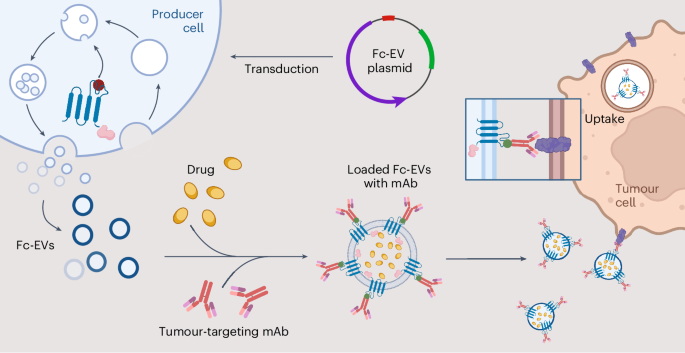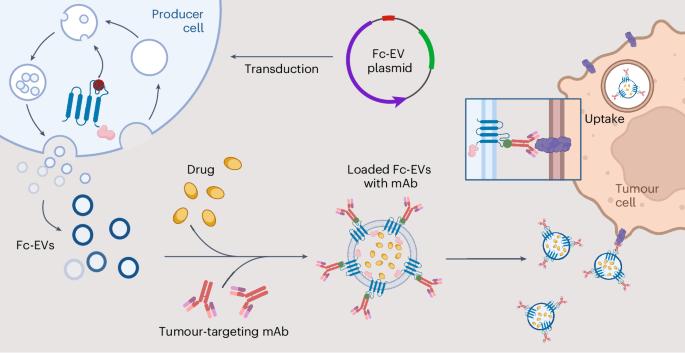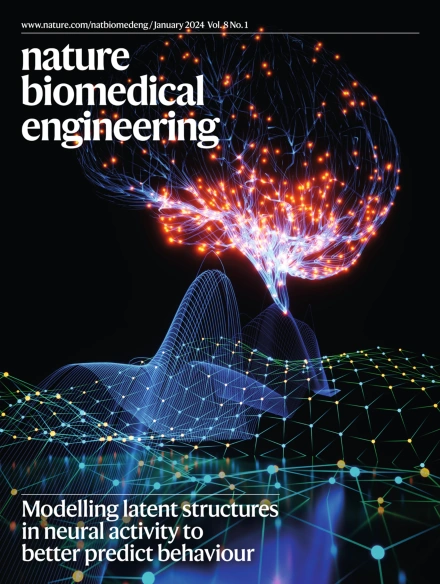用于癌症靶向治疗的抗体显示细胞外囊泡
IF 26.8
1区 医学
Q1 ENGINEERING, BIOMEDICAL
引用次数: 0
摘要
细胞外囊泡(EVs)具有天然递送载体和跨组织生物信号媒介的功能。在这里,通过利用这些功能,我们展示了用可结晶片段(Fc)结构域特异性抗体结合分子装饰的细胞外囊泡可用作癌症靶向治疗的模块化递送系统。Fc-EV可以用不同类型的免疫球蛋白G抗体装饰,因此几乎可以靶向治疗任何感兴趣的组织。通过筛选 Fc 结合和 EV 分类分子对工程化 EV 进行优化后,我们展示了 EV 对显示人类表皮受体 2 或程序性死亡配体 1 的癌细胞的靶向性,以及全身注射显示程序性死亡配体 1 抗体并装载化疗药物多柔比星的 EV 后,黑色素瘤皮下肿瘤小鼠的肿瘤负荷降低和存活期延长。具有 Fc 结合域的 EVs 可用于显示其他 Fc 融合蛋白、双特异性抗体和抗体-药物共轭物。本文章由计算机程序翻译,如有差异,请以英文原文为准。


Antibody-displaying extracellular vesicles for targeted cancer therapy
Extracellular vesicles (EVs) function as natural delivery vectors and mediators of biological signals across tissues. Here, by leveraging these functionalities, we show that EVs decorated with an antibody-binding moiety specific for the fragment crystallizable (Fc) domain can be used as a modular delivery system for targeted cancer therapy. The Fc-EVs can be decorated with different types of immunoglobulin G antibody and thus be targeted to virtually any tissue of interest. Following optimization of the engineered EVs by screening Fc-binding and EV-sorting moieties, we show the targeting of EVs to cancer cells displaying the human epidermal receptor 2 or the programmed-death ligand 1, as well as lower tumour burden and extended survival of mice with subcutaneous melanoma tumours when systemically injected with EVs displaying an antibody for the programmed-death ligand 1 and loaded with the chemotherapeutic doxorubicin. EVs with Fc-binding domains may be adapted to display other Fc-fused proteins, bispecific antibodies and antibody–drug conjugates. Extracellular vesicles decorated with an antibody-binding moiety specific for the fragment crystallizable domain can be used as a modular delivery system for targeted cancer therapy.
求助全文
通过发布文献求助,成功后即可免费获取论文全文。
去求助
来源期刊

Nature Biomedical Engineering
Medicine-Medicine (miscellaneous)
CiteScore
45.30
自引率
1.10%
发文量
138
期刊介绍:
Nature Biomedical Engineering is an online-only monthly journal that was launched in January 2017. It aims to publish original research, reviews, and commentary focusing on applied biomedicine and health technology. The journal targets a diverse audience, including life scientists who are involved in developing experimental or computational systems and methods to enhance our understanding of human physiology. It also covers biomedical researchers and engineers who are engaged in designing or optimizing therapies, assays, devices, or procedures for diagnosing or treating diseases. Additionally, clinicians, who make use of research outputs to evaluate patient health or administer therapy in various clinical settings and healthcare contexts, are also part of the target audience.
 求助内容:
求助内容: 应助结果提醒方式:
应助结果提醒方式:


